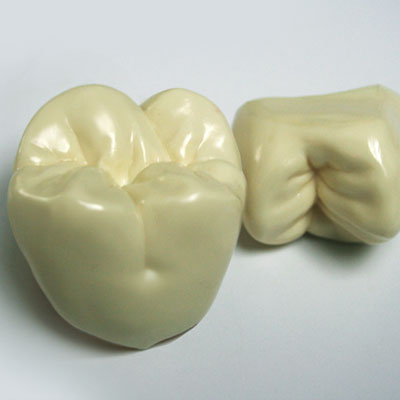Crowns & Bridges
 A crown (often called a cap) is an artificial cover that is placed on an individual tooth to restore a decayed or damaged tooth to its normal shape and size. This procedure is often necessary when there is no longer sufficient tooth structure left to place a filling. It is also useful for protecting teeth that are cracked or broken. A crown can also be used to change the shape of a tooth, to correct a bite or cosmetic problem or to replace existing broken or poor fitting crowns. A crown may be made of gold, other metals, or porcelain which makes them durable and strong, so replacements are needed less often. Because of its strength and resistance to chewing stress, a crown is functionally superior to other esthetic procedures.
A crown (often called a cap) is an artificial cover that is placed on an individual tooth to restore a decayed or damaged tooth to its normal shape and size. This procedure is often necessary when there is no longer sufficient tooth structure left to place a filling. It is also useful for protecting teeth that are cracked or broken. A crown can also be used to change the shape of a tooth, to correct a bite or cosmetic problem or to replace existing broken or poor fitting crowns. A crown may be made of gold, other metals, or porcelain which makes them durable and strong, so replacements are needed less often. Because of its strength and resistance to chewing stress, a crown is functionally superior to other esthetic procedures.
Crown Types
There are several types of esthetic crowns. The type of crown we will help you choose will depend on a number of factors, including the location of the tooth or teeth being crowned, the type and severity of the discoloration, and the overall health of the surrounding gums.
The Procedure

Fitting a crown is a two-step procedure. During your first visit we will prepare and reshape your tooth by removing enamel and dentin to allow room for the crown. You will be given anesthesia before hand. Then an impression of the prepared tooth and surrounding and opposing teeth is taken. Before you leave the office we will apply a temporary crown to protect the prepared tooth between visits
Expect to wait one week between visits while you crown is being made. At your second visit we will fit the permanent crown onto your tooth making sure it restores your tooth to its proper shape, look, and comfort level. If necessary we may have to adjust the crown by modifying the shape. Once the fit is the way you want, cement are applied and the crown is positioned securely onto your tooth. If the crown needs further changes, additional visits may be necessary.
Bridges
Fixed Bridges
Fixed bridges, quite simply, replace missing teeth to make chewing easier, improve appearance, and keep your teeth, gums, and jaws healthy. Bridges consist of one or more replacement teeth attached to the natural teeth next to them. They are made of various metals, porcelain, or a combination of the two.
Often people underestimate the value of every tooth in terms of beauty - even those in the back of the mouth. Although the spaces crated by these missing teeth may not be visible, they can cause a variety of problems and start a viscous cycle of destruction. In a normal healthy mouth, your teeth have a a natural balance. Each upper tooth contacts the corresponding lower tooth, allowing therefore a well-balanced chewing function. Losing a tooth quickly destroys this balance. Just one missing tooth can cause the position of other teeth to change - some teeth may tilt forward, or opposing teeth may move down. A missing tooth can also create spaces between your teeth, changing your bite and smile. These shifting, drifting, and titling teeth can cause a variety of problems such as difficult or painful chewing (due to changes in your muscles, bones, and joints), or abnormal decay areas (due to teeth that are hard to reach and keep clean) which accelerates periodontal (gum) disease.
Generally, if the missing tooth is not replaced, more teeth may eventually be lost due to the improper forces exerted during chewing.
In short, by replacing missing teeth you can:
- Help restore and maintain a natural bite
- Prevent unnatural stress on other teeth
- Help keep opposing teeth in their proper place
- Prevent shifting and tilting of adjacent teeth
- Help prevent further dental decay and periodontal disease
- Maximize your smile, speech and chewing function
Bridge Types
There are two main types of bridges: Conventional and Maryland. A conventional bridge has replacement teeth that are attached to crowns that fit over your natural teeth on either side of the space to be filled. The replacement teeth plus the crowns form a solid unit that is cemented into place to restore your natural bite.
A Maryland bridge has replacement teeth that are attached to the back of nearby natural teeth using a metal or porcelain strip. This type of bridge may be an option if the teeth next to the bridge are in good condition.
The Procedure
It will take two or more dental visits to prepare and fit you bridge. First we reshape the support teeth that will hold the crowns of your fixed bridge. Then an impression of the prepared tooth, and of the surrounding and opposing teeth, is taken.
If appearance counts, your dentist selects a colour from a guide to make sure the replacement teeth match the colour of your natural teeth. To protect your prepared teeth while the fixed bridge is being made, we may fit a temporary bridge that is held in place by temporary cement.
Between visits expect to wait about one week while the lab work is being done. At your second visit, your temporary bridge is removed and your dentist places the fixed bridge onto your prepared teeth, adjusting it in your mouth. When the fit and bite are comfortable, the fixed bridge is cemented into place.
We will help you decide which option is most effective and financially optimal for you so feel free to ask questions and help us answer your concerns.